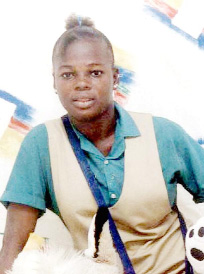After the submission, made by lead defence counsel Hukumchand last week, was upheld by Justice Ramlal, he then ordered the mixed jury to return a formal unanimous verdict of not guilty in favour of Bagot, also known as Paul Moore.
However, while Bagot, who is now 32 years old, has been cleared of the murder of his then 16-year-old girlfriend Abigail Gittens he was remanded to prison yesterday afternoon. There was an arrest warrant out for Bagot in for allegedly attempting to escape lawful custody.

It was alleged that on September 29, 2004 at Middle Road, East La Penitence, Georgetown, Bagot murdered Gittens. Bagot was charged with the murder on October 4, 2004 at the Georgetown Magistrates’ Court.
The High Court trial commenced early last month. Prosecutors Rhondel Weever and Shivanie Balcharan led the state’s case. Sonia and Kamini Parag were also on the defence team.
On September 29, 2004, Gittens, a former student of the St John’s College, had just gotten out of a bus at Middle Road when she was attacked. The teen, relatives had told Stabroek News, was returning to her Lot 191 Middle Road home after attending a friend’s birthday party.
Gittens was rushed to the Georgetown Public Hospital (GPH), where she succumbed to her wounds a day later. Before her death, reports further said, Gittens had related to her mother that she had just disembarked a minibus when she was hit by a motorcycle. Shortly after being hit, Gittens said she felt a burning sensation to the neck and realized that she had been stabbed. Her attacker, according to reports, continued plunging a sharp object into her body even as she cried for help.

Hukumchand made a no-case submission last Thursday in which he stated that there was not enough evidence to identify his client, Bagot, to be the attacker.
This submission was upheld by Justice Ramlal yesterday morning. The judge listed a number of reasons which led to him upholding the submission. Justice Ramlal also noted that this was one of several cases this year where weak evidence led by the prosecution resulted in a no-case submission being upheld.
No case submissions upheld
The prosecution was unable to attest to the reliability and credibility of a dying declaration reportedly made by Gittens at the GPH. Nelly Gittens, mother of the deceased, had told the court that during her dying declaration the teen only identified her attacker as “Paul”. No evidence was led by the prosecution to connect that “Paul” to the accused.
Further, evidence given by Nelly Gittens and another witness, Ken Isaacs, established that the area where Abigail was stabbed was dark. The prosecution, Justice Ramlal pointed out, did not lead evidence to prove that the area was sufficiently lit to allow for Gittens to identify her attacker.
In fact, the judge said, the prosecution never led evidence to determine the exact location where Gittens was murdered nor did it establish that the incident did occur. Justice Ramlal said that being someone’s boyfriend was not enough evidence to link a person to a crime.
Pathologist Vivekanand Brijmohan, during his testimony, told the court that Gittens may not have been able to speak because the fatal wounds she suffered would have blocked her air passages. This, Justice Ramlal said, contradicted Nelly Gittens’s report about the dying declaration.
However, there was evidence that Nelly Gittens did not like Bagot. Further, Nelly Gittens never gave the police a statement about the dying declaration her daughter made. Had Gittens survived and given what she said in her dying declaration as evidence then it would have failed to identify the accused as her attacker.
Justice Ramlal further stated that Nelly Gittens’s demeanor and outright refusal to answer questions during cross-examination put her evidence in an unreliable state and enough evidence was not led by the prosecution to prove without doubt that Bagot was a violent person. Finally, Justice Ramlal stated that the evidence led by the prosecution was weak, tenuous and unreliable. No jury, he said, can reasonably arrive at a verdict based on such evidence and it would be dangerous to allow such a thing to happen.
It was based on the above grounds that the judge upheld the no-case submissions.
Court cannot make bread out of stone
A court of law, more so the High Court, in any trial, be it civil and in particular criminal, can only act on evidence before it, that is; the evidence led by the prosecution, Justice Ramlal told Bagot.
“You would have been pronounced not guilty because of directions given to the jury… The formal verdict of not guilty that is what the record will reflect. Only you and your God will know,” the judge told Bagot.
Justice Ramlal said the investigation done by the police fell way below standard. The court, he said, did not know if the police ever made an attempt to obtain a statement from the witnesses present when Abigail Gittens allegedly made her dying declaration.
The doctor, nurse and security guard present during that time, Justice Ramlal said, never testified during the preliminary inquiry (PI) in the magistrates’ court because their names were not on the deposition. Investigators, the judge stressed, should have realized that these persons were important in this case.
The deceased, he stressed, did not die at the hospital and received medical intervention prior to her death. Although this was presented the court never heard what kind of medical intervention Gittens received. In fact, when he asked the prosecutor about this, the judge said, he was informed that they did not know which doctor had treated Gittens.
He further noted that the police investigation was so poor that it could not be determined where Abigail sustained the fatal wounds as distinct from where she was discovered.
“If this is how crime is going to be solved then we are in a bad state, really in a bad state,” Justice Ramlal said.
The bottom line is that the court can only act on the evidence before it and poor police investigation affects the prosecution’s performance in the court. Justice Ramlal said he had raised this particular issue in the past, but it did not seem as though anyone was taking the matter seriously.
“We [the court] cannot make bread out of stone. We can only work with the evidence before us… It is not the fault of the court if criminals are returning to the streets… The prosecutors cannot do anything about this as well. It all comes down to the investigation done by police,” he said.





